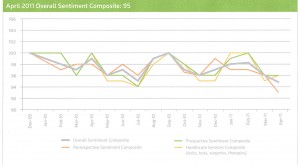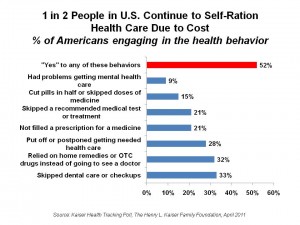 Americans are opting for Botox and cosmetic procedures more than colonoscopies and cancer tests, according to a story in Reuters.
Americans are opting for Botox and cosmetic procedures more than colonoscopies and cancer tests, according to a story in Reuters.
This trend makes companies like Allergan, makers of Botox and the Lap-Band for gastric surgery, very happy indeed. Plastics and gastric bypass surgeries are back up to pre-recession levels as of 2Q11.
However, for companies and providers in other segments of the health care and surgery value-chain, prospects for bounceback in 2011 aren’t as promising. Various indices on consumers’ health care sentiment — such as the Thomson-Reuters Consumer Healthcare Sentiment Index and the EBRI Health Confidence Survey, show U.S. consumers’ perceptions of their ability to pay for needed health care falling.
 Health Populi’s Hot Points: The Reuters story shows the chasm in U.S. health consumers’ mindsets between their “health” and “health care.” In the past 50 years, health ‘care’ has been an entitlement largely covered by health insurance, at or close to 100% with minimal co-payments, coinsurance, and premium sharing. In the past decade, however, enrollee out-of-pocket costs have skyrocketed, with the average employee covered for a family of 4 now paying about 40% of health costs, according to the 2011 Milliman Medical Index, explained here in Health Populi.
Health Populi’s Hot Points: The Reuters story shows the chasm in U.S. health consumers’ mindsets between their “health” and “health care.” In the past 50 years, health ‘care’ has been an entitlement largely covered by health insurance, at or close to 100% with minimal co-payments, coinsurance, and premium sharing. In the past decade, however, enrollee out-of-pocket costs have skyrocketed, with the average employee covered for a family of 4 now paying about 40% of health costs, according to the 2011 Milliman Medical Index, explained here in Health Populi.
Furthermore, Kaiser Family Foundation continues to track peoples’ self-rationing due to health costs. In their April 2011, tracking survey, 1 in 2 U.S. adults was seen to still cut pills in half, postpone recommended medical tests, delay dental care, and health “mis-behave” in other ways. Note that these are all self-rationing behaviors for health “care” issues.
So as we may skinny down our waistlines and de-wrinkle, our cancer diagnoses get delayed, costing us as patients precious time; our bank accounts, HSAs and health plan sponsors higher costs; and, diminishing public health. This scenario needs a good nudge toward value-based health plan design and positive consumer health behavior. Furthermore, health citizens need to connect-the-dots between prevention and outcomes, as well as whole health — that today’s health micro-choices bolster outcomes and quality of life for the long-term.




 Interviewed live on BNN Bloomberg (Canada) on the market for GLP-1 drugs for weight loss and their impact on both the health care system and consumer goods and services -- notably, food, nutrition, retail health, gyms, and other sectors.
Interviewed live on BNN Bloomberg (Canada) on the market for GLP-1 drugs for weight loss and their impact on both the health care system and consumer goods and services -- notably, food, nutrition, retail health, gyms, and other sectors. Thank you, Feedspot, for
Thank you, Feedspot, for  As you may know, I have been splitting work- and living-time between the U.S. and the E.U., most recently living in and working from Brussels. In the month of September 2024, I'll be splitting time between London and other parts of the U.K., and Italy where I'll be working with clients on consumer health, self-care and home care focused on food-as-medicine, digital health, business and scenario planning for the future...
As you may know, I have been splitting work- and living-time between the U.S. and the E.U., most recently living in and working from Brussels. In the month of September 2024, I'll be splitting time between London and other parts of the U.K., and Italy where I'll be working with clients on consumer health, self-care and home care focused on food-as-medicine, digital health, business and scenario planning for the future...